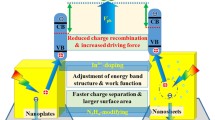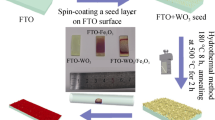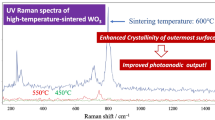Abstract
An ordered porous nanostructure provides a large reaction interface with an unusually high number of active sites, meaning that such a nanostructure is especially applicable to photoelectrochemical (PEC) water splitting. Therefore, we prepared WO3 films on W foil by pulsed anodization using square-pulse on/off voltage followed by calcination, and scrutinized the effects of reaction parameters—particularly the duty ratio, frequency, and F− ion content—on the surface morphology and PEC behavior of the films. The WO3 films produced with a pulsed voltage of 50 V, a duty ratio of 20%, and a pulse frequency of 200 Hz in an electrolyte of 0.06 M NH4F showed an ordered and porous morphology. WO3 films prepared under optimized conditions yielded a water splitting photocurrent density of 1.33 mA cm−2 at a bias potential of 1.2 V when exposed to AM 1.5 G 1-sun illumination in 0.5 M Na2SO4 electrolyte. The high PEC activity of the ordered porous WO3 films can be attributed to their ordered porous nanostructure, which results in a much larger surface area than in compact or disordered porous structures. Moreover, the ordered porous WO3 films also exhibited excellent stability and a high incident-photon-to-charge conversion efficiency (IPCE) of 57.8% at 350 nm and a bias potential of 1.2 V. This research demonstrates that the pulsed anodization technique allows the controlled fabrication of porous WO3 nanostructures for application in PEC water oxidation.










Similar content being viewed by others
References
Reyes-Gil KR, Stephens ZD, Stavila V, Robinson DB (2015) Composite WO3/TiO2 nanostructures for high electrochromic activity. ACS Appl Mater Interfaces 7:2202–2213
Kida T, Nishiyama A, Hua Z, Suematsu K, Yuasa M, Shimanoe K (2014) WO3 nanolamella gas sensor: porosity control using SnO2 nanoparticles for enhanced NO2 sensing. Langmuir 30:2571–2579
Hu M, Zeng J, Wang W, Chen H, Qin Y (2011) Porous WO3 from anodized sputtered tungsten thin films for NO2 detection. Appl Surf Sci 258:1062–1068
Yang Z, Ni X (2012) Photovoltaic hybrid films with polythiophene growing on monoclinic WO3 semiconductor substrates. Langmuir 28:4829–4834
Pervez SA, Kim D, Doh C-H, Farooq U, Choi H-Y, Choi J-H (2015) Anodic WO3 mesosponge@carbon: a novel binder-less electrode for advanced energy storage devices. ACS Appl Mater Interfaces 7:7635–7643
Liu C, Yang Y, Li W, Li J, Li Y, Shi Q, Chen Q (2015) Highly efficient photoelectrochemical hydrogen generation using ZnxBi2S3+x sensitized platelike WO3 photoelectrodes. ACS Appl Mater Interfaces 7:10763–10770
Ng C, Ng YH, Iwase A, Amal R (2013) Influence of annealing temperature of WO3 in photoelectrochemical conversion and energy storage for water splitting. ACS Appl Mater Interfaces 5:5269–5275
Singh T, Müller R, Singh J, Mathur S (2015) Tailoring surface states in WO3 photoanodes for efficient photoelectrochemical water splitting. Appl Surf Sci 347:448–453
Cui X, Shi J, Chen H, Zhang L, Guo L, Gao J, Li J (2008) Platinum/mesoporous WO3 as a carbon-free electrocatalyst with enhanced electrochemical activity for methanol oxidation. J Phys Chem B 112:12024–12031
Nam KM, Cheon EA, Shin WJ, Bard AJ (2015) Improved photoelectrochemical water oxidation by the WO3/CuWO4 composite with a manganese phosphate electrocatalyst. Langmuir 31:10897–10903
Patrocinio AOT, Paula LF, Paniago RM, Freitag J, Bahnemann DW (2014) Layer-by-layer TiO2/WO3 thin films as efficient photocatalytic self-cleaning surfaces. ACS Appl Mater Interfaces 6:16859–16866
Zhang G, Guan W, Shen H, Zhang X, Fan W, Lu C, Bai H, Xiao L, Gu W, Shi W (2014) Organic additives-free hydrothermal synthesis and visible-light-driven photodegradation of tetracycline of WO3 nanosheets. Ind Eng Chem Res 53:5443–5450
Zhang LJ, Li S, Liu BK, Wang DJ, Xie TF (2014) Highly efficient CdS/WO3 photocatalysts: Z-scheme photocatalytic mechanism for their enhanced photocatalytic H2 evolution under visible light. ACS Catal 4:3724–3729
Arutanti O, Nandiyanto ABD, Ogi T, Kim TO, Okuyama K (2015) Influences of porous structurization and Pt addition on the improvement of photocatalytic performance of WO3 particles. ACS Appl Mater Interfaces 7:3009–3017
DePuccio DP, Botella P, O’Rourke B, Landry CC (2015) Degradation of methylene blue using porous WO3, SiO2–WO3, and their Au-loaded analogs: adsorption and photocatalytic studies. ACS Appl Mater Interfaces 7:1987–1996
Tolod KR, Hernández S, Russo N (2017) Recent advances in the BiVO4 photocatalyst for sun-driven water oxidation: top-performing photoanodes and scale-up challenges. Catalysts 7:13
Liu Y, Li Y, Li W, Han S, Liu C (2012) Photoelectrochemical properties and photocatalytic activity of nitrogen-doped nanoporous WO3 photoelectrodes under visible light. Appl Surf Sci 258:5038–5045
Zhao W, Wang Z, Shen X, Li J, Xu C, Gan Z (2012) Hydrogen generation via photoelectrocatalytic water splitting using a tungsten trioxide catalyst under visible light irradiation. Int J Hydrog Energy 37:908–915
Kim JK, Shin K, Choi D-G, Park JH (2011) Fabrication and photocatalytic effects of tungsten trioxide nano-pattern arrays. Mater Express 1:245–251
Mi Q, Coridan RH, Brunschwig BS, Gray HB, Lewis NS (2013) Photoelectrochemical oxidation of anions by WO3 in aqueous and nonaqueous electrolytes. Energy Environ Sci 6:2646–2653
Yang C, Zhu Q, Zhang S, Zou Z, Tian K, Xie C (2014) A comparative study of microstructures on the photoelectric properties of tungsten trioxide films with plate-like arrays. Appl Surf Sci 297:116–124
Liu Y, Li J, Li W, Yang Y, Li Y, Chen Q (2015) Enhancement of the photoelectrochemical performance of WO3 vertical arrays film for solar water splitting by gadolinium doping. J Phys Chem C 119:14834–14842
Weinhardt L, Blum M, Bär M, Heske C, Cole B, Marsen B, Miller EL (2008) Electronic surface level positions of WO3 thin films for photoelectrochemical hydrogen production. J Phys Chem C 112:3078–3082
Vasilopoulou M, Kostis I, Vourdas N, Papadimitropoulos G, Douvas A, Boukos N, Kennou S, Davazoglou D (2014) Influence of the oxygen substoichiometry and of the hydrogen incorporation on the electronic band structure of amorphous tungsten oxide films. J Phys Chem C 118:12632–12641
Choi Y-W, Kim S, Seong M, Yoo H, Choi J (2015) NH4-doped anodic WO3 prepared through anodization and subsequent NH4OH treatment for water splitting. Appl Surf Sci 324:414–418
Cristino V, Caramori S, Argazzi R, Meda L, Marra GL, Bignozzi CA (2011) Efficient photoelectrochemical water splitting by anodically grown WO3 electrodes. Langmuir 27:7276–7284
Ou JZ, Rani RA, Balendhran S, Zoolfakar AS, Field MR, Zhuiykov S, O’Mullane AP, Kalantar-zadeh K (2013) Anodic formation of a thick three-dimensional nanoporous WO3 film and its photocatalytic property. Electrochem Commun 27:128–132
Zheng Q, Lee C (2014) Visible light photoelectrocatalytic degradation of methyl orange using anodized nanoporous WO3. Electrochim Acta 115:140–145
Syrek K, Zych M, Zaraska L, Sulka GD (2017) Influence of annealing conditions on anodic tungsten oxide layers and their photoelectrochemical activity. Electrochim Acta 231:61–68
Altomare M, Pfoch O, Tighineanu A, Kirchgeorg R, Lee K, Selli E, Schmuki P (2015) Molten o-H3PO4: a new electrolyte for the anodic synthesis of self-organized oxide structures—WO3 nanochannel layers and others. J Am Chem Soc 137:5646–5649
Tsuchiya H, Macak JM, Sieber I, Taveira L, Ghicov A, Sirotna K, Schmuki P (2005) Self-organized porous WO3 formed in NaF electrolytes. Electrochem Commun 7:295–298
Jeong SH, Im HL, Hong S, Park H, Baek J, Dong HP, Kim S, Hong YK (2017) Massive, eco-friendly, and facile fabrication of multi-functional anodic aluminum oxides: application to nanoporous templates and sensing platforms. RSC Adv 7:4518–4530
Hao Q, Huang H, Fan X, Hou X, Yin Y, Li W, Si L, Nan H, Wang H, Mei Y (2017) Facile design of ultra-thin anodic aluminum oxide membranes for the fabrication of plasmonic nanoarrays. Nanotechnology 28:105301
Chung CK, Dhandapani D, Syu CJ, Liao MW, Chu BY, Kuo EH (2017) Role of oxalate anions on the evolution of widened pore diameter and characteristics of room-temperature anodic aluminum oxide. J Electrochem Soc 164:C121–C127
Nebol’sin VA, Spiridonov BA, Dunaev AI, Bogdanovich EV (2017) Preparation of nanoporous titanium oxide films by electrochemical anodic oxidation. Inorg Mater 53:595–601
Li S, Zhang G, Guo D, Yu L, Zhang W (2009) Anodization fabrication of highly ordered TiO2 nanotubes. J Phys Chem C 113:12759–12765
Stergiopoulos T, Valota A, Likodimos V, Speliotis T, Niarchos D, Skeldon P, Thompson GE, Falaras P (2009) Dye-sensitization of self-assembled titania nanotubes prepared by galvanostatic anodization of Ti sputtered on conductive glass. Nanotechnology 20:365601
Stępniowski WJ, Bojar Z (2011) Synthesis of anodic aluminum oxide (AAO) at relatively high temperatures. Study of the influence of anodization conditions on the alumina structural features. Surf Coat Technol 206:265–272
Takenaga A, Kikuchi T, Natsui S, Suzuki RO (2015) Self-ordered aluminum anodizing in phosphonoacetic acid and its structural coloration. ECS Solid State Lett 4:P55–P58
Wei W, Shaw S, Lee K, Schmuki P (2012) Rapid anodic formation of high aspect ratio WO3 layers with self-ordered nanochannel geometry and use in photocatalysis. Chem Eur J 18:14622–14626
Wang X, Zhang S, Sun L (2011) A two-step anodization to grow high-aspect-ratio TiO2 nanotubes. Thin Solid Films 519:4694–4698
Yoo JE, Lee K, Altomare M, Selli E, Schmuki P (2013) Self-organized arrays of single-metal catalyst particles in TiO2 cavities: a highly efficient photocatalytic system. Angew Chem Int Ed 52:7514–7517
Yoo J, Lee K, Schmuki P (2013) Dewetted au films form a highly active photocatalytic system on TiO2 nanotube-stumps. Electrochem Commun 34:351–355
Lee K, Mazare A, Schmuki P (2014) One-dimensional titanium dioxide nanomaterials: nanotubes. Chem Rev 114:9385–9454
Macak JM, Tsuchiya H, Ghicov A, Yasuda K, Hahn R, Bauer S, Schmuki P (2007) TiO2 nanotubes: self-organized electrochemical formation, properties and applications. Curr Opin Solid State Mater Sci 11:3–18
Chung CK, Chu BY, Tsai CH, Hsu CR (2017) Photoluminescence enhancement of nanoporous alumina using one-step anodization of high- and low-purity aluminum at room temperature. Mater Lett 190:157–160
Chung CK, Tsai CH, Hsu CR, Kuo EH, Chen Y, Chung IC (2017) Impurity and temperature enhanced growth behaviour of anodic aluminium oxide from AA5052 Al-Mg alloy using hybrid pulse anodization at room temperature. Corros Sci 125:40–47
Lee W, Scholz R, Gösele U (2008) A continuous process for structurally well-defined Al2O3 nanotubes based on pulse anodization of aluminum. Nano Lett 8:2155–2160
Chanmanee W, Watcharenwong A, Chenthamarakshan CR, Kajitvichyanukul P, de Tacconi NR, Rajeshwar K (2008) Formation and characterization of self-organized TiO2 nanotube arrays by pulse anodization. J Am Chem Soc 130:965–974
Chen Y, Santos A, Wang Y, Kumeria T, Li J, Wang C, Losic D (2015) Biomimetic nanoporous anodic alumina distributed Bragg reflectors in the form of films and microsized particles for sensing applications. ACS Appl Mater Interfaces 7:19816–19824
Wang Y, Chen Y, Kumeria T, Ding F, Evdokiou A, Losic D, Santos A (2015) Facile synthesis of optical microcavities by a rationally designed anodization approach: tailoring photonic signals by nanopore structure. ACS Appl Mater Interfaces 7:9879–9888
Kim WT, Choi WY (2017) Fabrication of TiO2 photonic crystal by anodic oxidation and their optical sensing properties. Sensor Actuat A Phys 260:178–184
Kim D-J, Ahn Y, Lee S-H, Kim Y-K (2006) Voltage pulse frequency and duty ratio effects in an electrochemical discharge microdrilling process of Pyrex glass. Int J Mach Tool Manu 46:1064–1067
Zhang X, Chandra D, Kajita M, Takahashi H, Li D, Shoji A, Saito K, Yui T, Yagi M (2014) Facile and simple fabrication of an efficient nanoporous WO3 photoanode for visible-light-driven water splitting. Int J Hydrog Energy 39:20736–20743
Zeng Q, Li J, Bai J, Li X, Xia L, Zhou B (2017) Preparation of vertically aligned WO3 nanoplate array films based on peroxotungstate reduction reaction and their excellent photoelectrocatalytic performance. Appl Catal B 202:388–396
Ismail S, Chai YN, Ahmadi E, Razak KA, Lockman Z (2016) Segmented nanoporous WO3 prepared via anodization and their photocatalytic properties. J Mater Res 31:1–8
Li W, Jie L, Xuan W, Sha L, Xiao J, Chen Q (2010) Visible light photoelectrochemical responsiveness of self-organized nanoporous WO3 films. Electrochim Acta 56:620–625
Reyes-Gil KR, Wiggenhorn C, Brunschwig BS, Lewis NS (2013) Comparison between the quantum yields of compact and porous WO3 photoanodes. J Phys Chem C 117:14947–14957
Chai Y, Tam CW, Beh KP, Yam FK, Hassan Z (2015) Effects of thermal treatment on the anodic growth of tungsten oxide films. Thin Solid Films 588:44–49
Chai YN, Razak KA, Lockman Z (2015) Effect of annealing temperature on anodized nanoporous WO3. J Porous Mater 22:537–544
Ma M, Zhang K, Li P, Jung MS, Jeong MJ, Park JH (2016) Dual oxygen and tungsten vacancies on a WO3 photoanode for enhanced water oxidation. Angew Chem 55:11819–11823
Liu Y, Chen P, Chen Y, Lu H, Wang J, Yang Z, Lu Z, Li M, Fang L (2016) In situ ion-exchange synthesis of SnS2/g-C3N4 nanosheets heterojunction for enhancing photocatalytic activity. RSC Adv 6:10802–10809
Liu Y, Geng P, Wang J, Yang Z, Lu H, Hai J, Lu Z, Fan D, Li M (2017) In-situ ion-exchange synthesis Ag2S modified SnS2 nanosheets toward highly photocurrent response and photocatalytic activity. J Colloid Interface Sci 512:784
Pan JH, Sun DD, Lee C, Kim YJ, Lee WI (2010) Effect of calcination temperature on the textural properties and photocatalytic activities of highly ordered cubic mesoporous WO3/TiO2 films. J Nanosci Nanotech 10:4747–4751
Kamal H, Akl AA, Abdel-Hady K (2004) Influence of proton insertion on the conductivity, structural and optical properties of amorphous and crystalline electrochromic WO3 films. Physica B 349:192–205
Li W, Li J, Wang X, Ma J, Chen Q (2010) Photoelectrochemical and physical properties of WO3 films obtained by the polymeric precursor method. Int J Hydrog Energy 35:13137–13145
Hernández S, Saracco G, Barbero G, Alexe-Ionescu AL (2017) Role of the electrode morphology on the optimal thickness of BiVO4 anodes for photoelectrochemical water splitting cells. J Electroanal Chem 799:481–486
Vidyarthi VS, Hofmann M, Savan A, Sliozberg K, König D, Beranek R, Schuhmann W, Ludwig A (2011) Enhanced photoelectrochemical properties of WO3 thin films fabricated by reactive magnetron sputtering. Int J Hydrog Energy 36:4724–4731
Nukui Y, Srinivasan N, Shoji S, Atarashi D, Sakai E, Miyauchi M (2015) Vertically aligned hexagonal WO3 nanotree electrode for photoelectrochemical water oxidation. Chem Phys Lett 635:306–311
Ederth J, Hoel A, Niklasson GA, Granqvist CG (2004) Small polaron formation in porous WO3−x nanoparticle films. J Appl Phys 96:5722–5726
Acknowledgements
This work was supported by the National Natural Science Foundation of China (21363006, 21503051), the Natural Science Foundation of Guangxi (2015GXNSFBA139029, 2016GXNSFAA380121, 2016GXNSFAA380219) and Guilin Scientific Research and Technology Development Projects (KY2015ZL109).
Author information
Authors and Affiliations
Corresponding authors
Electronic supplementary material
ESM 1
(DOCX 260 kb)
Rights and permissions
About this article
Cite this article
Lu, H., Yan, Y., Zhang, M. et al. The effects of adjusting pulse anodization parameters on the surface morphology and properties of a WO3 photoanode for photoelectrochemical water splitting. J Solid State Electrochem 22, 2169–2181 (2018). https://doi.org/10.1007/s10008-018-3911-5
Received:
Revised:
Accepted:
Published:
Issue Date:
DOI: https://doi.org/10.1007/s10008-018-3911-5




